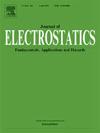介电材料在月球环境中的摩擦起电作用
IF 2.1
4区 工程技术
Q3 ENGINEERING, ELECTRICAL & ELECTRONIC
引用次数: 0
摘要
包括嫦娥六号在内的中国探月计划旨在实现未来的载人任务和一个研究站。月球环境和人类活动,如月球车、太空服和月球尘埃之间的摩擦,构成了严重的充电危险,可能产生千伏特范围内的电压。本文研究了在真空、紫外光和不同温度下材料与模拟月球尘埃之间的摩擦电荷效应。实验结果表明,聚四氟乙烯在真空条件下可充电至- 375 V,在紫外光下可充电至- 200 V,在大气条件下可充电至- 39 V。不同温度下的摩擦电现象表明,在- 50°C时发生最剧烈的充电,达到- 1975 V。这些发现为未来月球任务的潜在充电和放电风险提供了见解。本文章由计算机程序翻译,如有差异,请以英文原文为准。
Triboelectrification of dielectric material in the lunar environment
China's lunar exploration, including Chang'e−6, aims for future manned missions and a research station. The lunar environment and human activity, such as friction between rovers, spacesuits, and lunar dust, pose serious charging hazards, potentially generating voltages in the kilovolt range. This paper investigates the frictional charging effects between materials and simulated lunar dust under vacuum, UV light, and varying temperatures. Experimental results show that Teflon can be charged to −375 V in vacuum, −200 V under UV light, and −39 V in the atmosphere. Triboelectrification at different temperatures reveals the most severe charging occurs at −50 °C, reaching −1975 V. These findings provide insights into potential charge and discharge risks for future lunar missions.
求助全文
通过发布文献求助,成功后即可免费获取论文全文。
去求助
来源期刊

Journal of Electrostatics
工程技术-工程:电子与电气
CiteScore
4.00
自引率
11.10%
发文量
81
审稿时长
49 days
期刊介绍:
The Journal of Electrostatics is the leading forum for publishing research findings that advance knowledge in the field of electrostatics. We invite submissions in the following areas:
Electrostatic charge separation processes.
Electrostatic manipulation of particles, droplets, and biological cells.
Electrostatically driven or controlled fluid flow.
Electrostatics in the gas phase.
 求助内容:
求助内容: 应助结果提醒方式:
应助结果提醒方式:


